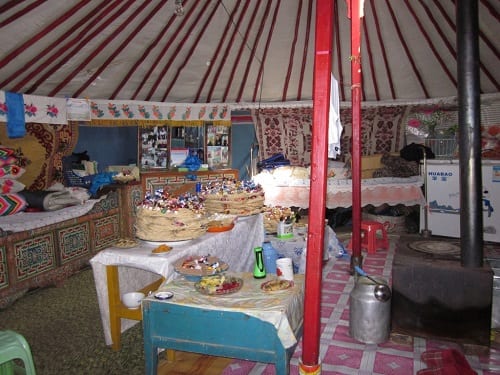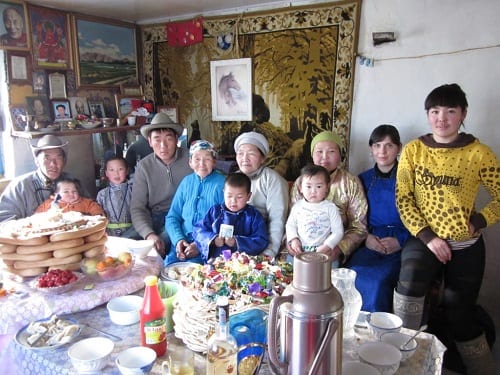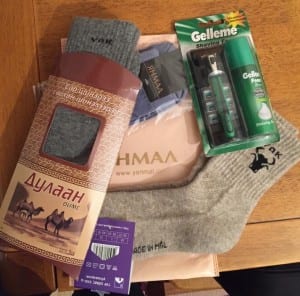The Tsagaan Sar Gift Index – 2015
By ucsaar0, on 11 March 2015
By Rebecca Empson and Uranchimeg Ujeed, with contributions by members of the Emerging Subjects project
In line with our aim of observing the economy from ‘unusual angles’, over the next 3 years we will look at the kinds of gifts people are giving and receiving during Tsagaan Sar – the annual Lunar New Year celebrations in Mongolia.
The economy in Mongolia is currently experiencing high inflation and currency depreciation. By tracing the kinds of gifts given and received over this period we hope to gain some insight into the way in which household economies and important moments of displaying wealth and hospitality, such as enacting hierarchy and status, are shaped by the wider economic climate, and vice versa. We will call this the Tsagaan Sar Gift Index.
This is the first of such posts. It has been co-written by different members of our group, including Lauren Bonilla, Joseph Bristley, Rebecca Empson, Elizabeth Fox, Rebekah Plueckhahn, Uranchimeg Ujeed and Hedwig Waters, with perspectives from Mongolia and Inner Mongolia. The format may change somewhat each year according to our focus.
Ritual Practices
Tsagaan Sar (lit. ‘white month’ or ‘moon’, or Shineleh lit. ‘to renew’) is an important occasion both spiritually and socially. Certain traditions are observed to set the household on the ‘right path’ for the year ahead. These practices form an essential background to the widespread act of gift giving and receiving, and so we begin by recounting them in some detail.
Tsagaan Sar tends to fall in February, depending on the Mongolian lunar calendar. While diversities exist in the way people celebrate, some broad commonalities may be highlighted.
Officially, celebration starts on the 23rd day of the last Lunar month when the annual family fire offering is conducted. On this day, families thoroughly sweep and dust their households from top to bottom. They burn incense to purify the house and a fire offering is carried out (in Inner Mongolia offerings are also made to ancestors at this time).
The next major celebration is on New Year’s Eve, or Bitüün (lit. closed) and a celebration called Bitüüleh (to close, or to contain the old year) is performed. At dusk, another offering is made to the family’s ancestors and people tend to eat ‘closed foods’, such as buuz (round dumplings) or biyansh (triangular dumplings). Every household prepares their New Year tabag (a big wooden plate piled with layers of fried cakes and dairy foods to display on the table when greeting guests on New Year’s day).

Inside a ger after the family has left to visit relatives on the second day of Tsagaan Sar (Photo by Lauren Bonilla, 2012)
On the morning of New Year’s Day (shiniin negen, lit. first of the new) people put on their new clothes and the head of the family leads members outside where they light a fire and make prostrations to the old year and greet the New Year (in some cases, this offering is made on a surrounding spiritually-significant mountain by the males of the family). Inside, they may prostrate to the family alter, and then greet (zolgoh) the elders of the family by presenting a ceremonial silk scarf and a cup of alcohol. Elder family members tend to recite auspicious words while children are prostrating.
Children may place their palms facing downwards to those of their elders, which are facing upwards, and say sain shinelbüü (have you had a good renewal)? Elders often give money to the children while saying zoosond adli böh yav, zoosond adli önggötöi yav (lit. be as tough as money and as appreciated as money). Then, in some parts, family members may light some incense and walk a hundred steps in an auspicious direction related to their age as a way to ‘open the road’ (mor gargah) for the New Year.
During the day people visit relatives, starting with a visit to the most senior relative, and onwards to the most junior. Nobody should be greeted empty handed, and often a bottle of alcohol, a piece of brick tea, or a packet of cakes with a hadag is given to the host. In return, people often give a scarf, a towel, or a pair of socks.[1] People try to see (zolgoh) all of their relatives over the next couple of days.
In general, Tsagaan Sar celebrations are concerned with getting rid of anything ‘bad, ‘old’, ‘dirty’, or ‘troublesome’ (muu, huuchin, buzar burtag, gai barchid) that may hinder the New Year and many of the rituals are concerned with setting the path for a ‘fresh’, ‘clean’, and ‘auspicious’ (shine sorgog, ariun tsever, ölzii mörtöi) New Year. There is a saying that mongol hün belgeer, hitad hün beneer (Mongols [do things] by symbol/auspice, Chinese [do things] by value/capital). Nowadays, as we will see, the value of beleg or ‘gift’ and capital is changing.
Social Hierarchy and Obligation
While attending to these kind of customary practices, Tsagaan Sar is also a performative occasion in which people’s hierarchical relations and economic status is enacted, exposed, honored and re-made, through the giving of gifts and sharing of food. Indeed, it is sometimes common for people to ask one another, especially young children, during the celebrations, ‘ail ih hesej, alt möngö ih tsugluulsan uu?’ (did you visit many other families and collect a lot of gold and silver?). This may indicate the emphasis of visiting families to collect gifts, and the way the value of these gifts are received and given different weight.
As Mauss noted, gift giving is not simply altruistic. Giving a gift creates relations of obligation because every gift contains the expectation of some kind of counter-gift. The gift obliges a person to reciprocate what has been received and enter into real contracts. Sometimes the chain of gift and counter-gift creates networks that span several generations. Gift exchange, during Tsagaan Sar, whether people like it or not, makes peoples social relations visible in the exchange of things and reaffirms social bonds and hierarchical status.
The way gift giving reinforces hierarchical relations in Mongolia is something that has been noted by Aude Michelet (2013) in her work on the way children learn hierarchy in the Gobi.[2] Michelet notes that children first have to learn to receive things from adults (rather than simply helping themselves). ‘Learning to receive and to give’, Michelet notes, ‘is one of the basic [skills] used in interacting with others’ (Michelet 2013: 147).
In this sense, giving represents an act of obligation (not always simply one of generosity) that is highly formalized (Michelet 2013:150) and establishes hierarchy between the giver and the receiver. For children it is about learning that you will also, in turn, receive your share according to hierarchy, gender and status.

Visiting, feasting and gifting. The young child in the center holds money he collected from visiting the homes of relatives and honoring elders. (Photo by Lauren Bonilla, 2012)
Examples from 2014 and 2015
We turn now to accounts of recent gift giving during Tsagaan Sar celebrations in Mongolia, from the countryside and the city. To contextualize some of these accounts and note the changes, let us first look at an example from last year.
In Bulgan Province, in 2014, for example, Joseph Bristley comments that the kinds of gifts given to people ranged from baroque-style vases, small Erdenet carpets and elaborate boxes of chocolates, to smaller items of clothes (socks, gloves), and packs of playing cards. Money was often also given, ranging from 10,000 tögrög (T) for close kin, to 1,000T for other visitors.[3] Visitors only gave money to their hosts, and often as much as they would receive as a gift on leaving.
In contrast, this year (2015), Liz Fox notes that the kinds of items exchanged among one extended family in the ger district of Ulaanbaatar (UB) and Töv Aimag included relatively small gifts and less money, such as woolen socks, scarves, a t-shirt, and chocolates and sweets, and money that ranged from 1000 to 5000T, as well as special Tsagaan Sar-themed Mobicom or Skytel credit top-up cards (value 1000T).
In comparison, a lawyer in UB, from an upper-middle class family, mentioned to Hedwig Waters that her extended family was focused on gifting items ‘Made in Mongolia’. Gifting Mongolian-made goods was seen as a way of supporting the national economy (despite many knowing they actually came from Ereen, China). In addition to supporting the local economy, this woman’s family also debated if they should switch from gifting gifts to gifting money.
It seems that some city residents always question if the celebration has become too consumer-oriented. By gifting tiny sums of money, people could, it was speculated, enjoy the giving without the focus on (and stress of) object consumption. Indeed, this woman’s family gave each other socks, mostly because they had lost interest in gifting expensive items.[4] But those around her seemed to be debating the need to support the Mongolian economy, while spending and consuming less in general.
Extending this focus on celebrations in the city, Javkaa, a 33-year-old male, in UB, commented to Lauren Bonilla that celebrating Tsagaan Sar in the city poses certain difficulties. For a start, it often starts with intense traffic, making visiting relatives very arduous. Furthermore, ‘if we make buuz and try to freeze them [outdoors] in order to have enough for visitors, we will eat buuz with air pollution.’
Javkaa laments that celebrating in the city:
‘…causes depression for most people instead of excitement. Despite their low salaries, young people want to make their parents happy and they have to buy a lot for the celebration. Minimally, we have to buy meat which is expensive because we do not have livestock in the city. Furthermore, we have to find gifts. These are mostly cheap Chinese trash because we do not produce many products. In doing so, the Chinese get rich but we just accumulate debt. Many people in the city borrow money for this celebration. Unfortunately, these products from China are not high quality and most people do not use them after the celebration’.
This year Javkaa visited 3 families and received many Mongolian-branded gifts that filled him with a sense of joy.
‘I got Mongolian camel wool socks from one family’, he commented, ‘another gave me Mongolian socks and Golden Gobi chocolate. While a third family gave me socks and a can of gellete shaving cream from Russia.

Gifts received by a young man in Ulaanbaatar. The socks on the left were specially made for Tsagaan Sar, with the words, ‘Happy Beginning of the New Year’ written on the top. (Photo by Javkaa, 2015)
Javkaa also commented that many purchased items for Tsagaan Sar from Russia this year because Mongolians can now visit Russia for 30 days visa-free, increasing trade and business.
Rebekah Plueckhahn’s friend, a young man in his late 20s, viewed this year’s Tsagaan Sar in Ulaanbaatar as a mixed experience. He described how some families seemed to celebrate as usual, while others celebrated in a more ‘compact and efficient way’, including choosing to celebrate for a less number of days, allowing a family to gain the spiritual and esoteric benefits of hosting Tsagaan Sar, but in a more affordable way.
Given recent inflation, the cost of hosting Tsagaan Sar was a bit higher than usual. As a youngest son, Rebekah’s friend didn’t need to host anyone at his house, but on average, in order to host a 2-3 day celebration he estimated that people have to save at least 1,000,000 to 1,500,000T in advance. Many families, he noted, gave gifts of cheap socks and gloves, something that was seen as a bit funny, but also a bit sad.
His family chose to give chocolates and candies with a 1,000T note (approximately 50 US cents). This 1,000T note was chosen because of its blue colour, reminiscent of the overarching sky (Tenger), and a Mongolian ceremonial blue scarf (hadag).
This, and other accounts of Tsagaan Sar in 2015, paint a picture where people are either maintaining a kind of gift exchange ‘equilibrium’, by keeping their celebration modestly consistent with previous years, or by deciding to downsize this year’s celebration in response to an over-all climate of far-less economic opportunity.
Less days, more socks, made in Mongolia
By making the celebration more ‘compact’, by hosting and visiting less people for a shorter number of days, people are still able to carry out gift exchange in the right way but for a lower over-all cost.
This leaning towards austerity by some, is reflected further by Rebekah’s friend, who laments the fact that, recently, many families have had to: ‘look for other job opportunities in a smaller market with less employers.’ People are feeling this sudden lack of opportunity, especially if they have made adjustments in previous years when anticipating a certain form of personal, financial growth.
Despite this scaling back, Tsagaan Sar continues to form a pivotal, cyclical point in the spiritual, temporal and familial landscape in Mongolia. Indeed, Rebekah’s friend exclaimed that while ‘it was hard…many Mongolians pulled through it with tradition that must be held strong.’
From this brief overview we may surmise that the celebrations of 2015 were not so much centered around forms of conspicuous consumption and display, but tended to focus more on giving gifts that were affordable and if possible, supported the national economy. ‘Made in Mongolia’ gifts were prevalent.
Some seemed to confine the celebrations to less days, thereby visiting and receiving less people (and reducing the number of relations honored and also the number of gifts given and received). Others, while observing important traditions, scaled down the event to make it more affordable, and a feature mentioned by many was the prevalence of gifting money or socks, which was seen as thrifty and nationally-minded, as well as slightly pitiful of the current economic climate.
As Brad Evans and Julian Reid remind us in their book, Resilient Life, these are not particular responses.[5] Contemporary liberalism, they suggest, requires us to live with precariousness and insecurity. People in Mongolia and elsewhere are continually tasked to be resilient by adapting to and bouncing back from the experiences of economic growth and its sudden decline. When the Tsagaan Sar gift economy appears to move toward scaling-down, localism, and debt accumulation, we might be able to trace another space in which resilience is becoming naturalized and normalized.
[1] In the past, a New Year gift was called tsagaan sariin tsaason beleg (lit. paper gift of the tsagaan sar, just symbolic, nothing major). If an elderly person’s animal year falls, called jil oroh (enter the year) and greatly honored. Children and close relatives as well as close friend would normally give a piece silk or cloth for garment and boots etc. Especially boots are considered auspicious as they are opening upwards, hats are avoided as they are opening down. The fifteenth of Tsagaan Sar is the day people would visit monasteries as there were molomiin hural (wish making service) and tsam dances conducted there. Generally Tsagaan Sar celebrations end at this time but if someone has not been able to greet any relatives, he/she still can do it until the end of the month. People would greet by saying sain shinelbüü?
[2] Michelet, Aude P. 2013 Chapter 6: Learning to Share without Being Generous, No Longer ‘Kings’ Learning to be a Mongolian Person in the Middle Gobi, September 2013, unpublished PhD thesis submitted for the degree of Doctor of Philosophy, Department of Anthropology, London School of Economics and Political Sciences.
[3] At the time of this post, 1000T roughly equals USD $0.50.
[4] Giving socks may also be a way of maintaining the auspicious tradition of giving gifts that open upwards, in a similar way that boots were popular gifts in the past. Only gifts that open upwards instead downwards (like hats) are given during Tsagaan Sar because they symbolize collecting and keeping good fortune for the new year.
[5] Evans, Brad and Reid, Julian 2014 Resilient Life: The Art of Living Dangerously, Cambridge: Polity Press
 Close
Close




